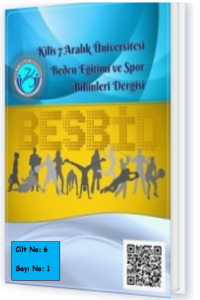THE COMPETITION STRATEGIES FOR 20 KM FEMALE RACE-WALKING BASED ON LAPS VARIABLES
Athletics, 20 km walking race, competition
___
- Abaf. (2023). 22th Balkan Race Walking Championships - Antalya 2023. ABAF Results. http://www.balkan-athletics.eu/results.php
- Alves, D. L., Cruz, R., Bara, C. L. B. P., Ruy-Barbosa, M. A., Osiecki, R., & Lima, J. R. P. (2021). Does sex, distance and performance level influence the pacing strategy of race walkers? Sport Sciences for Health, 17(2), 335–340.
- Di Gironimo, G., Caporaso, T., Del Giudice, D. M., Tarallo, A., & Lanzotti, A. (2016). Development of a new experimental protocol for analysing the race-walking technique based on kinematic and dynamic parameters. Procedia engineering, 147, 741–746.
- Drake, A., Cox, V., Godfrey, R., & Brooks, S. (2003). Physiological variables related to 20 km race walk performance. Journal of Sports Sciences, 21, 269–270.
- Hanley, B., Bissas, A., & Drake, A. (2011). Kinematic characteristics of elite men’s and women’s 20 km race walking and their variation during the race. Sports Biomechanics, 10(02), 110–124. IAAF. (2017). Competition Rules 2018-2019. International Association of Athletics Federations. http://www.iaaf.org
- Jelonek, J., Wiesław, P., Świat, M., Michalski, C., & Stec, K. (2017). Quality of sports training and the biological adaptation of athletes to race walking. Physical Activity Review, 5, 212–221.
- Ma, T. (2021). The Curative Effect of Traditional Chinese Medicine Compounded Medications in Relieving Racewalking Fatigue. Revista Brasileira de Medicina do Esporte, 27, 91–94.
- Menting, S. G. P., Hanley, B., Elferink-Gemser, M. T., & Hettinga, F. J. (2021). Pacing behaviour of middle-long distance running \& race-walking athletes at the IAAF U18 and U20 World Championship finals. European Journal of Sport Science, 1–10.
- Morley, B., & Thomas, D. (2005). An investigation of home advantage and other factors affecting outcomes in English one-day cricket matches. Journal of Sports Sciences, 23(3), 261–268. https://doi.org/10.1080/02640410410001730133
- Pupiš, M., Czaková, M., & Pavlović, R. (2016). Pace Variability Of A Female Race Walker In A 20 Km Racing Event. Acta Kinesiologica, 10(1), 23–28.
- Yoshida, T., Udo, M., Iwai, K., Muraoka, I., Tamaki, K., Yamaguchi, T., & Chida, M. (1989). Physiological determinants of race walking performance in female race walkers. British journal of sports medicine, 23(4), 250–254.
- ISSN: 2667-5447
- Başlangıç: 2017
- Yayıncı: Kilis 7 Aralık Üniversitesi
Basketbol Hakemlerinin Algıladıkları Stres Düzeyleri ve Başa Çıkma Yöntemlerinin İncelenmesi
Takım ve Bireysel Sporcuların Zihinsel Dayanıklılık Düzeylerinin İncelenmesi
Berzan ŞİMŞEK, Alpaslan KARTAL
9-10 Yaş Çocuklarda 10 Haftalık Muay-Thai Antrenmanının Bazı Motorik Özellikler Üzerine Etkisi
Futbolda Pliometrik Antrenmanların Dayanıklılık Belirteçleri Üzerine Etkisi
Berzan ŞİMŞEK, Tolga HANAYOĞLU, Berkan BOZDAĞ
THE COMPETITION STRATEGIES FOR 20 KM FEMALE RACE-WALKING BASED ON LAPS VARIABLES
Nuray SATILMIŞ, Yeliz AY YILDIZ, Pelin AVCI, Akan BAYRAKDAR, Işık BAYRAKTAR
Sporcuların Algıladıkları Antrenör Liderlik Davranışlarının Bazı Değişkenlere Göre İncelenmesi
Tolga HANAYOĞLU, Ece ERVÜZ, Berzan ŞİMŞEK, Mehmet GÜÇLÜ, Mehmet YILDIRIM
Yakup YILDIRIM, Ahmet İNAL, Mehmet Fatih YALDIZ
Gelişim Ligi Futbolcularının Göreceli Yaş Etkisinin İncelenmesi: Türkiye U19 Elit A Ligi Örneği
